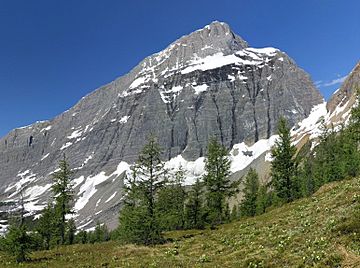Foster Peak facts for kids
Quick facts for kids Foster Peak |
|
|---|---|

Foster Peak
|
|
| Highest point | |
| Elevation | 3,201 m (10,502 ft) |
| Prominence | 996 m (3,268 ft) |
| Parent peak | Mount Goodsir (3567 m) |
| Geography | |
| Location | Kootenay National Park British Columbia, Canada |
| Parent range | Vermilion Range Canadian Rockies |
| Topo map | NTS 82N01 |
| Geology | |
| Age of rock | Cambrian |
| Type of rock | Ottertail Limestone |
| Climbing | |
| First ascent | 1933 Kate Gardiner, Ken Jones, Walter Feuz |
Foster Peak is a tall mountain, about 3,201 meters (10,502 feet) high. It sits right on the edge of Kootenay National Park in British Columbia, Canada. It's the highest point in the Vermilion Range, which is part of the amazing Canadian Rockies.
The closest mountain that's even taller is Mount Ball, about 15 kilometers (9 miles) away. Foster Peak is also part of a famous hiking area called 'The Rockwall'. Nearby, Floe Lake is a really beautiful spot in the park. You can reach this area by hiking on the Floe Lake Trail or the Rockwall Trail. The Rockwall Trail is a long, scenic path, about 55 kilometers (34 miles) long. It takes you through mountain passes, green meadows, and past huge limestone cliffs.
Mountain History: How Foster Peak Got Its Name
Foster Peak was named in 1913 after a famous Canadian, William Wasbrough Foster. He was an important person who loved exploring mountains. In the same year, William Foster was the first person to climb Mount Robson. Mount Robson is the highest point in the Canadian Rockies.
Later, in 1925, Foster was also part of the first team to climb Mount Logan. This is the highest mountain in all of Canada! The name 'Foster Peak' was officially recognized in 1927. The first time anyone successfully climbed Foster Peak was in 1933. This climb was done by Kate (Katie) Gardiner and Ken Jones, with Walter Feuz as their guide.
The Rocks of Foster Peak: A Look at Geology
Foster Peak is made mostly of a type of rock called Ottertail limestone. Limestone is a sedimentary rock. This means it formed over millions of years from layers of tiny bits of rock, shells, and other materials. These layers were laid down during ancient times, from the Precambrian to the Jurassic periods.
Over time, powerful forces inside the Earth pushed these rock layers. This process, called the Laramide orogeny, caused the rocks to fold and lift. It pushed older rocks up and over younger rocks, creating the mountains we see today.
Weather and Climate Around Foster Peak
Foster Peak has a subarctic climate. This means it has very cold, snowy winters and mild summers. The weather here is classified using the Köppen climate classification system.
Winter temperatures can drop below −20 °C (minus 4 °F). With the wind, it can feel even colder, sometimes below −30 °C (minus 22 °F). The snow and rain that fall on the mountain eventually drain away. Water from the east side flows into Floe Creek and Numa Creek. These creeks then join the Vermilion River. Water from the west side flows into parts of the Kootenay River.



